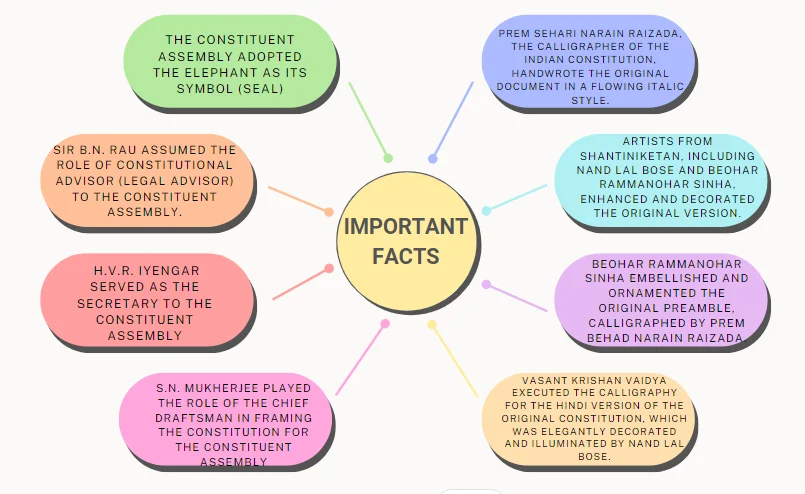The Indian Constitution draws from a wide range of sources, blending elements from various countries to create a unique legal framework. From the British parliamentary system to the American emphasis on fundamental rights, each borrowed feature has contributed to shaping India’s governance structure. Despite these efforts, the Constituent Assembly faced criticism for its lawyer-politician dominance, perceived lack of representation, and extended timeline.
Sources of the Constitution #
| S no. | Source | Features Borrowed |
| 1 | Government of India Act of 1935 |
|
| 2 | British Constitution |
|
| 3 | Irish Constitution |
|
| 4 | US Constitution |
|
| 5 | Canadian Constitution |
|
| 6 | Australian Constitution |
|
| 7 | Weimar Constitution of Germany |
|
| 8 | Soviet Constitution (USSR, now
Russia) |
|
| 9 | French Constitution |
|
| 10 | South African Constitution |
|
| 11 | Japanese Constitution |
|
Enroll now for UPSC Online Course
Criticism of the Constituent Assembly #
In spite of various efforts, the Constituent Assembly also faced criticisms, outlined as follows
- Lawyer-Politician Dominance: Constituent Assembly was predominantly controlled by lawyers and politicians, emphasizing the insufficient representation of other societal segments.
- According to critics, this is the main reason for the bulkiness and complicated language of the Constitution.
- Lack of Representativeness: Constituent Assembly lacked true representativeness since the people of India did not directly elect its members through universal adult franchise.
- Non-Sovereign Status: Critics argued that the Constituent Assembly was not sovereign, asserting its creation was based on British Government proposals.
- Assembly conducted its sessions with the permission of the British Government.
- Time-Consuming: Constituent Assembly took an unduly long time to make the Constitution.
- The American Constitution took only four months to complete their work.
- Naziruddin Ahmed, a member of the Constituent Assembly, termed the Drafting Committee as a “Drifting Committee”.
- Congress Party Dominance: The Constituent Assembly was overwhelmingly influenced by the Congress party.
- Granville Austin, an American Constitutional expert, remarked that the Assembly functioned as a one-party entity in a predominantly one-party country, asserting that the Congress was synonymous with India.
- Hindu Dominance: Constituent Assembly displayed a Hindu-centric dominance.
- Viscount Simon referred to it as ‘a body of Hindus,’ and Winston Churchill commented that the Assembly represented ‘only one major community in India.
Indian Constitution #

Language of the Constitution #
The original Constitution of India did not initially include any provision regarding an authoritative Hindi version. However, the 58th Constitutional Amendment Act of 1987 addressed this by introducing a new Article 394-A in Part XXII. This article outlines the following provisions:
- The President is mandated to publish:
-
- The translation of the Constitution into the Hindi language.
- Necessary modifications can be made to align it with the language, style, and terminology of authoritative texts of the Central Acts in Hindi, incorporating all amendments made before such publication.
- The Hindi translation of each Constitutional amendment made in English.
- The published translations of the Constitution and its amendments are to be interpreted to have the same meaning as the original English text.
- In case of any difficulty in this matter, the President has the authority to appropriately revise the Hindi text.
| Articles | Subject matter |
| 393 |
|
| 394 |
|
| 394A |
|
| 395 |
|
Enroll now for UPSC Online Course
| Must Read | |
| Current Affairs | Editorial Analysis |
| Upsc Notes | Upsc Blogs |
| NCERT Notes | Free Main Answer Writing |
Conclusion #
Although the Indian Constitution is a comprehensive document influenced by global practices, it faced challenges in its creation, including allegations of Congress and Hindu dominance. The language of the Constitution was later addressed through the 58th Amendment, ensuring an authoritative Hindi version, reflecting India’s linguistic diversity.
Sign up for the PWOnlyIAS Online Course by Physics Wallah and start your journey to IAS success today!
| Related Articles | |
| Major Constitutional Amendments | FUNDAMENTAL RIGHTS (UDAAN) |
| Preamble of the Indian Constitution | Constituent Assembly of India |

 GS Foundation
GS Foundation Crash Course
Crash Course Combo
Combo Optional Courses
Optional Courses Degree Program
Degree Program










